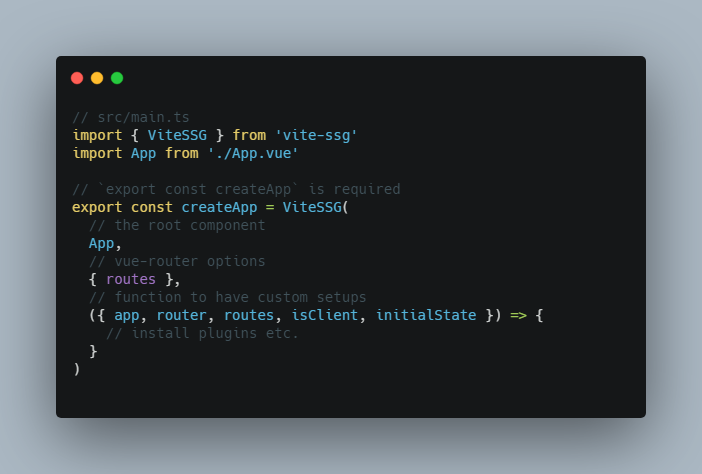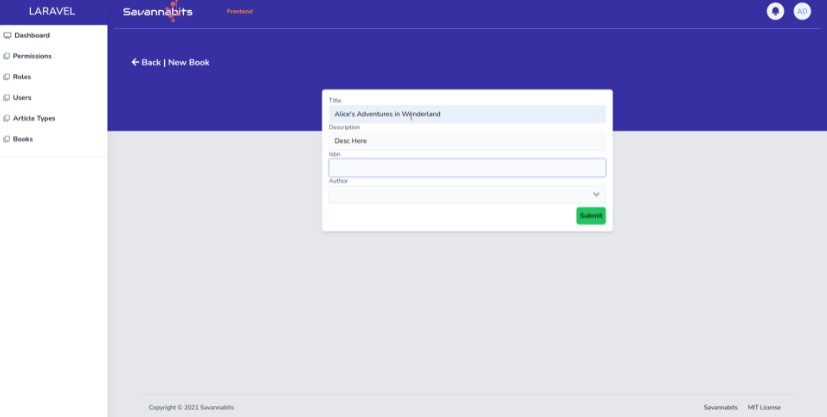Vite SSG
Server-side generation for Vue 3 on Vite.
ℹ️ Vite 2 is supported from
v0.2.x, Vite 1's support is discontinued.
Install
This library requires Node.js version >= 14
npm i -D vite-ssg @vue/server-renderer @vue/compiler-sfc vue-router@next @vueuse/head
// package.json
{
"scripts": {
"dev": "vite",
- "build": "vite build"
+ "build": "vite-ssg build"
}
}
// src/main.ts
import { ViteSSG } from 'vite-ssg'
import App from './App.vue'
// `export const createApp` is required
export const createApp = ViteSSG(
// the root component
App,
// vue-router options
{ routes },
// function to have custom setups
({ app, router, routes, isClient, initialState }) => {
// install plugins etc.
}
)
Single Page SSG
To have SSG for the index page only (without vue-router), import from vite-ssg/single-page instead.
import { ViteSSG } from 'vite-ssg/single-page'
export const createApp = ViteSSG(App)
<ClientOnly/>
Component ClientOnly is registered globally along with the app creation.
<client-only>
<your-client-side-components />
</client-only>
Document head
From v0.4.0, we ship @vueuse/head to manage the document head out-of-box. You can directly use it in your pages/components, for example:
<template>
<button @click="count++">Click</button>
</template>
<script setup>
import { useHead } from '@vueuse/head'
useHead({
title: 'Website Title',
meta: [
{
name: `description`,
content: `Website description`,
},
],
})
</script>
That's all, no configuration is needed. Vite SSG will handle the server-side rendering and merging automatically.
Refer to @vueuse/head's docs for more usage about useHead.
Critical CSS
Vite SSG has built-in support for generating Critical CSS inlined in the HTML via the critters package. Install it via:
npm i -D critters
Critical CSS generation will be enabled automatically for you.
Initial State
The initial state comprises data that is serialized to your server-side generated HTML that is hydrated in
the browser when accessed. This data can be data fetched from a CDN, an API, etc, and is typically needed
as soon as the application starts or is accessed for the first time.
The main advantage of setting the application's initial state is that the statically generated pages do not
need to fetch the data again as the data is fetched during build time and serialized into the page's HTML.
The initial state is a plain JavaScript object that can be set during SSR, i.e., when statically generating
the pages, like this:
// src/main.ts
// ...
export const createApp = ViteSSG(
App,
{ routes },
({ app, router, routes, isClient, initialState }) => {
// ...
if (import.meta.env.SSR) {
// Set initial state during server side
initialState.data = { cats: 2, dogs: 3 }
} else {
// Restore or read the initial state on the client side in the browser
console.log(initialState.data) // => { cats: 2, dogs: 3 }
}
// ...
}
)
Typically, you will use this with an application store, such as
Vuex or Pinia.
For examples, see below:
When using Pinia
Following [Pinia's guide](https://pinia.esm.dev/ssr), you will to adapt your `main.{ts,js}` file to look like this:
// main.ts
import { ViteSSG } from 'vite-ssg'
import { createPinia } from 'pinia'
import routes from 'virtual:generated-pages'
// use any store you configured that you need data from on start-up
import { useRootStore } from './store/root'
import App from './App.vue'
export const createApp = ViteSSG(
App,
{ routes },
({ app, router, initialState }) => {
const pinia = createPinia()
app.use(pinia)
if (import.meta.env.SSR) {
initialState.pinia = pinia.state.value
} else {
pinia.state.value = initialState.pinia || {}
}
router.beforeEach((to, from, next) => {
const store = useRootStore(pinia)
if (!store.ready)
// perform the (user-implemented) store action to fill the store's state
store.initialize()
next()
})
},
)
When using Vuex
// main.ts
import { ViteSSG } from 'vite-ssg'
import routes from 'virtual:generated-pages'
import { createStore } from 'vuex'
import App from './App.vue'
// Normally, you should definitely put this in a separate file
// in order to be able to use it everywhere
const store = createStore({
// ...
})
export const createApp = ViteSSG(
App,
{ routes },
({ app, router, initialState }) => {
app.use(store)
if (import.meta.env.SSR) {
initialState.store = store.state
} else {
store.replaceState(initialState.store)
}
router.beforeEach((to, from, next) => {
// perform the (user-implemented) store action to fill the store's state
if (!store.getters.ready)
store.dispatch('initialize')
next()
})
},
)
For the example of how to use a store with an initial state in a single page app,
see the single page example.
State Serialization
Per default, the state is deserialized and serialized by using JSON.stringify and JSON.parse.
If this approach works for you, you should definitely stick to it as it yields far better
performance.
You may use the option transformState in the ViteSSGClientOptions as displayed below.
A valid approach besides JSON.stringify and JSON.parse is
@nuxt/devalue (which is used by Nuxt.js):
import devalue from '@nuxt/devalue'
import { ViteSSG } from 'vite-ssg'
// ...
import App from './App.vue'
export const createApp = ViteSSG(
App,
{ routes },
({ app, router, initialState }) => {
// ...
},
{
transformState(state) {
return import.meta.env.SSR ? devalue(state) : state
},
},
)
A minor remark when using @nuxt/devalue: In case, you are getting an error because of a require
within the package @nuxt/devalue, you have to add the following piece of config to your Vite config:
// vite.config.ts
//...
export default defineConfig({
resolve: {
alias: {
'@nuxt/devalue': '@nuxt/devalue/dist/devalue.js',
},
},
// ...
})
Configuration
You can pass options to Vite SSG in the ssgOptions field of your vite.config.js
// vite.config.js
export default {
plugins: [ /*...*/ ],
ssgOptions: {
script: 'async'
}
}
See src/types.ts. for more options available.
Custom Routes to Render
You can use the includedRoutes hook to exclude/include route paths to render, or even provide some complete custom ones.
// vite.config.js
export default {
plugins: [ /*...*/ ],
ssgOptions: {
includedRoutes(routes) {
// exclude all the route paths that contains 'foo'
return routes.filter(i => !i.includes('foo'))
}
}
}
Comparsion
Use Vitepress when you want:
- Zero config, out-of-box
- Single-purpose documentation site
- Lightweight (No double payload)
Use Vite SSG when you want
- More controls on the build process and tooling
- The flexible plugin systems
- Multi-purpose application with some SSG to improve SEO and loading speed
Cons:
- Double payload
Example
See Vitesse





